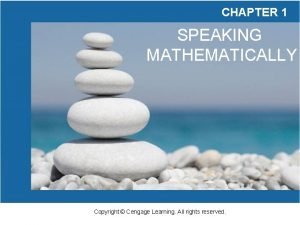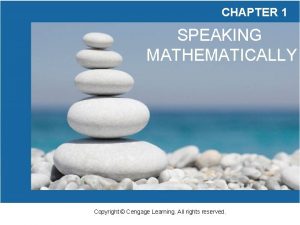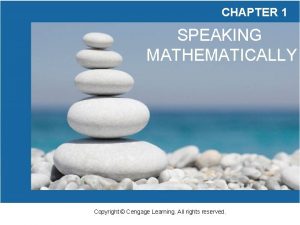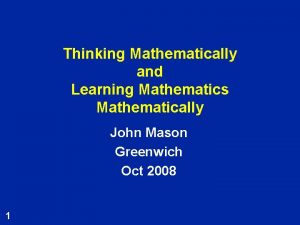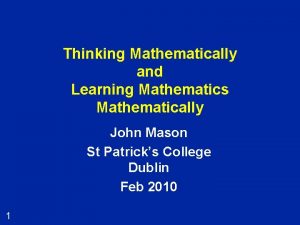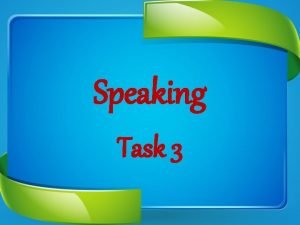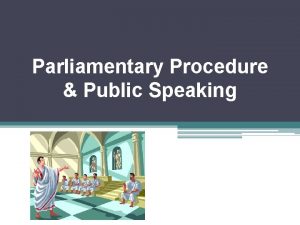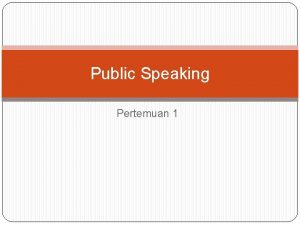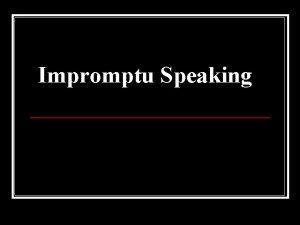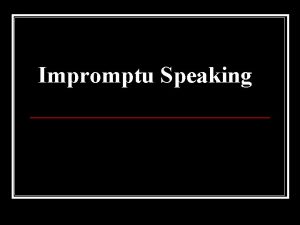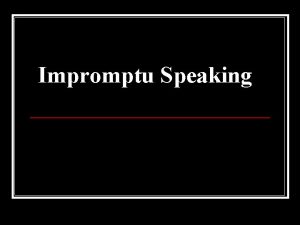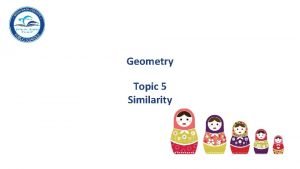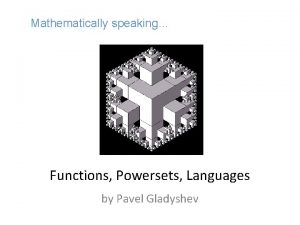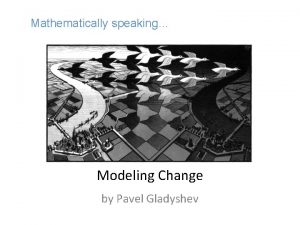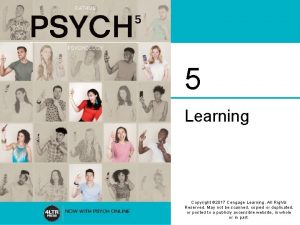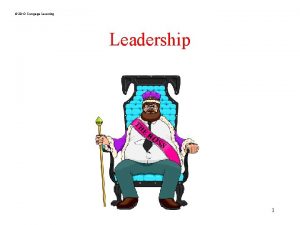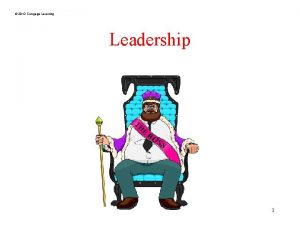CHAPTER 1 SPEAKING MATHEMATICALLY Copyright Cengage Learning All





















- Slides: 21

CHAPTER 1 SPEAKING MATHEMATICALLY Copyright © Cengage Learning. All rights reserved.

SECTION 1. 2 The Language of Sets Copyright © Cengage Learning. All rights reserved.

The Language of Sets 3

The Language of Sets Use of the word set as a formal mathematical term was introduced in 1879 by Georg Cantor (1845– 1918). For most mathematical purposes we can think of a set intuitively, as Cantor did, simply as a collection of elements. For instance, if C is the set of all countries that are currently in the United Nations, then the United States is an element of C, and if I is the set of all integers from 1 to 100, then the number 57 is an element of I. 4

The Language of Sets The axiom of extension says that a set is completely determined by what its elements are—not the order in which they might be listed or the fact that some elements might be listed more than once. 5

Example 1 – Using the Set-Roster Notation a. Let A = {1, 2, 3}, B = {3, 1, 2}, and C = {1, 1, 2, 3, 3, 3}. What are the elements of A, B, and C? How are A, B, and C related? b. Is {0} = 0? c. How many elements are in the set {1, {1}}? d. For each nonnegative integer n, let Un = {n, –n}. Find U 1, U 2, and U 0. 6

The Language of Sets Certain sets of numbers are so frequently referred to that they are given special symbolic names. These are summarized in the following table: 7

The Language of Sets The set of real numbers is usually pictured as the set of all points on a line, as shown below. The number 0 corresponds to a middle point, called the origin. A unit of distance is marked off, and each point to the right of the origin corresponds to a positive real number found by computing its distance from the origin. 8

The Language of Sets Each point to the left of the origin corresponds to a negative real number, which is denoted by computing its distance from the origin and putting a minus sign in front of the resulting number. The set of real numbers is therefore divided into three parts: the set of positive real numbers, the set of negative real numbers, and the number 0. Note that 0 is neither positive nor negative. 9

The Language of Sets Labels are given for a few real numbers corresponding to points on the line shown below. The real number line is called continuous because it is imagined to have no holes. The set of integers corresponds to a collection of points located at fixed intervals along the real number line. 10

The Language of Sets Thus every integer is a real number, and because the integers are all separated from each other, the set of integers is called discrete. The name discrete mathematics comes from the distinction between continuous and discrete mathematical objects. Another way to specify a set uses what is called the builder notation. set- 11

Example 2 – Using the Set-Builder Notation Given that R denotes the set of all real numbers, Z the set of all integers, and Z+ the set of all positive integers, describe each of the following sets. a. b. c. 12

Subsets 13

Subsets A basic relation between sets is that of subset. 14

Subsets It follows from the definition of subset that for a set A not to be a subset of a set B means that there is at least one element of A that is not an element of B. Symbolically: 15

Example 4 – Distinction between ∈ and ⊆ Which of the following are true statements? a. 2 ∈ {1, 2, 3} d. {2} ⊆ {1, 2, 3} b. {2} ∈ {1, 2, 3} e. {2} ⊆ {{1}, {2}} c. 2 ⊆ {1, 2, 3} f. {2} ∈ {{1}, {2}} 16

Cartesian Products 17

Cartesian Products 18

Example 5 – Ordered Pairs a. Is (1, 2) = (2, 1)? b. Is ? c. What is the first element of (1, 1)? 19

Cartesian Products 20

Example 6 – Cartesian Products Let A = {1, 2, 3} and B = {u, v}. a. Find A × B b. Find B × A c. Find B × B d. How many elements are in A × B, B × A, and B × B? e. Let R denote the set of all real numbers. Describe R × R. 21
 Universal existential statement examples in math
Universal existential statement examples in math Cengage chapter 7
Cengage chapter 7 Speaking mathematically examples
Speaking mathematically examples Rewriting a universal existential statement example
Rewriting a universal existential statement example Chapter 13 medical math assignment sheet
Chapter 13 medical math assignment sheet The human respiratory system chapter 7 handout
The human respiratory system chapter 7 handout Chapter 6:2 interpreting word parts
Chapter 6:2 interpreting word parts Cengage chapter 5
Cengage chapter 5 Cengage learning heart diagram
Cengage learning heart diagram South-western cengage learning
South-western cengage learning 2009 delmar cengage learning
2009 delmar cengage learning Cengage learning heart diagram
Cengage learning heart diagram 2009 delmar cengage learning
2009 delmar cengage learning Cengage learning australia
Cengage learning australia 2009 delmar cengage learning
2009 delmar cengage learning Cengage learning
Cengage learning Cengage learning
Cengage learning Wadsworth cengage learning
Wadsworth cengage learning Cengage learning
Cengage learning Cengage learning plant cell
Cengage learning plant cell Cengage learning
Cengage learning Cengage learning
Cengage learning


